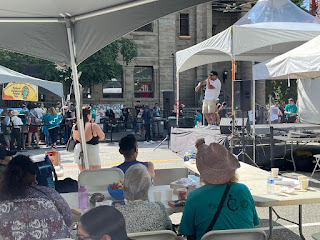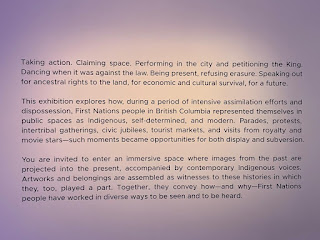Salutations and gentle tidings fellow readers of the blog! Here is another blog instalment written by the Allergy Brigade!
Today is National Indigenous People’s Day. It is a day that marks not only the longest day of the year, the solstice, but it is also a day that many Indigenous people celebrate their cultural and heritage. As a settler I am continually learning about the past and present acts of colonialism, assimilation, and genocide of First Nations, Métis, and Inuit people. This is something that I put the the utmost importance on not only as a Canadian, but as a future Teacher. Knowing about these acts and how to explain them to students is an act of the truth part in truth and reconciliation. To honour this, a small group of us went to the newly renovated museum of anthropology. This was an opportunity to think about the past, present, and future interactions between Canada’s First Peoples, settlers, and the Canadian Government.
The museum as installed a new exhibition called “To Be Seen To Be Heard - First Nations in Public Spaces, 1900-1965.” This exhibition brings a light to how First Nations people represented themselves in the public as “indigenous, self-determined, and modern.” This exhibit has a collection of modern art, regalia, clothing, and other prices. The main part of the exhibit is a documentary primarily composed of short video clips and pictures accompanied by various First Nations modern narrators. The narrators describe and explain the acts of colonialism and assimilation during this time period and how it impacted their family and communities. This was an incredibly informative viewpoint as much of the dialogue is from personal accounts, not widely known to many people. This is an incredibly important addition to the museum and I strongly encourage those who visit to sit in the room and listen to these voices and their stories.
Sarah Frehlick
On Friday June 21, 2024 we were invited to attend an event to celebrate Indigenous cultures and traditions. I chose to attend the Carnegie Centre Street Party.
The event took place on the 400 block of Main Street. The day presented an opportunity for people of all backgrounds to come together and celebrate the traditions of the First Nations, Inuit, and Metis peoples.
As I entered the venue I was struck by the generosity of greetings and of food being offered. There were cookies, apples, bananas, oranges, and saskatoon berry tea offered at no cost. The tea tasted like the saskatoon berry jam I remembered making as a child. The cups were generous and welcomed on the hot day.
Next, I was struck with the covered seating that was placed in front of the stage. It made for a great spot to watch the Haida Dance Group, an amazing rapper who got the crowd dancing, and a couple who played the drums.
Then, I explored the booths. I was impressed with the warmth of the vendors, but also the hard truths that were shared through story. I was handed a piece of moose hide. I was told it symbolizes standing up towards violence towards women and children. Another booth had beautiful clothes called, ‘Decolonized Clothing.’ She is an artist who will host pop up shops throughout the summer. Her shirts were gorgeous and weaved in messages of awareness of whose land we are on and the importance of nature.
Finally, I came across a woman handing out art and medicine bags. The medicine bags were made with local sage, tobacco, and cedar. She stated the bag would help me and others feel connected to spirit, to each other, and to the community on this day.
I left the event feeling nourished, educated, and connected. I am grateful that this day was given to us in the field experience curriculum to explore and celebrate Indigenous cultures and traditions in the community.
Today, I spent my time at the UBC Museum of Anthropology. I spent most of my time wandering around the main floor of the museum. Most of the floor was lit by the tall windows of the museum, so it was incredibly bright on such a sunny day!
There were two exhibits that especially stood out to me during my visit. The first was a collection of bentwood boxes with the following plaques:
https://drive.google.com/file/d/1acnLpq49sJFnFfRDfkhflXJ0fuziUDVX/view?usp=drivesdk
https://drive.google.com/file/d/1adykZvUwQb2isneJ-aQWvZB31LLR9BBe/view?usp=drivesdk
The other exhibit that struck me was in Pursuit of Venus [infected] by Lisa Reihana. It features an immersive, panoramic, looping video based on the artwork Les Sauvages de la Mer Pacifique (The native peoples of the Pacific Ocean) by Jean-Gabriel Charvet—a wallpaper set that adorned wealthy homes in the 1800s. I took a picture of one of the plaques that explain the artwork below:
https://drive.google.com/file/d/1aheUBYU5mjy1Lf6oAmJIhxtRpT2ejb6W/view?usp=drivesdk
The room was very dim, and with the loud surround sound it was quite an impactful piece. I noticed that the tone of the piece told a story of the arrival of Europeans to the Pacific Islands as it transitioned from the different Indigenous peoples of the islands experiencing peace and joy to their first contacts with Europeans, finally building in volume and tempo to the violence that the Indigenous peoples experienced at the hands of European colonizers.
You can also view the work for free on YouTube through the Auckland Art Gallery’s channel here: https://www.youtube.com/watch?v=WmMRF5nw9UI&t=20s
Both works really made me reflect on how objects can carry such strong cultural significance. The bentwood boxes, for instance, reminded me how the cultural practice of craftsmanship can be carried from generation to generation, and just how important it is to keep that practice safe and alive through belongings for future generations. In Pursuit of Venus [infected] also showed me how objects and works of art can reduce others’ experiences for the purpose of others’ enjoyment or pleasure; for me, this became evident through the juxtaposition between the original work’s use almost as a way to “tour” or “experience” the Pacific Islands and Reihana’s exploration of the reality of European violent colonialism.
All in all, I really enjoyed the Museum of Anthropology and learned a lot there! There was so much to experience that there wasn’t enough time for it all. Until next time!
One of the most captivating pieces for me was the artwork crafted from cedar planks. This included a segment of a house screen that dated back over 200 years. The intricate linework and imagery only became visible under the right amount of lighting, creating a mysterious and enchanting effect. In contrast, other parts of the screen had eroded over time. The combination of erosion and remnants of paint formed a subtle texture on the wood, which highlighted the artwork in a unique and compelling way when you applied the correct amount of lighting. This was both a visually stunning piece and I loved the interactive nature of it
With this I hope that everyone has had a lovely day and I hope you are well!
Best,
The Allergy Brigade













No comments:
Post a Comment